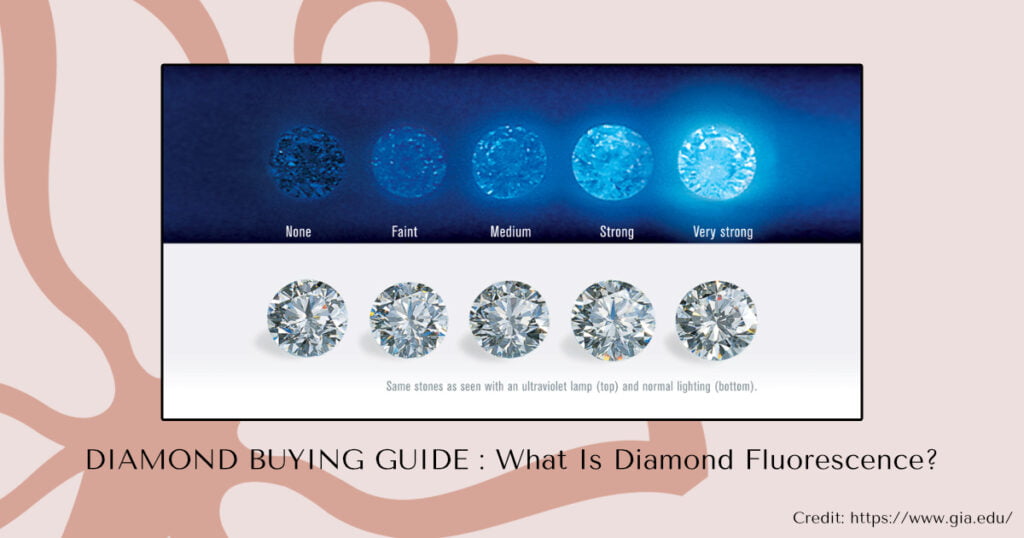Story
Diamond Buying Guide : What Is Diamond Fluorescence?
When it comes to evaluating diamonds, there are numerous factors to consider, such as the 4Cs (cut, clarity, color, and carat weight). However, one characteristic that often sparks discussion and curiosity is diamond fluorescence. This article aims to provide an understanding of diamond fluorescence, its impact on the appearance of diamonds, and the percentage by which it can influence diamond pricing.
1. What is Diamond Fluorescence?
Diamond fluorescence refers to the phenomenon where a diamond emits a visible glow or fluorescence under ultraviolet (UV) light. This optical effect is caused by the interaction of the diamond’s atomic structure with UV radiation, resulting in the emission of a colored glow. The most common fluorescence colors observed are blue, but yellow and other colors can also occur. It’s important to note that not all diamonds exhibit fluorescence, and its intensity can range from none (no fluorescence) to faint, medium, strong, and even very strong.
2. How Diamond Fluorescence Affects Diamonds:
The impact of diamond fluorescence on a diamond’s appearance and value is a complex subject. While fluorescence is not inherently negative, it can affect a diamond in various ways:
a) Visual Appearance: In some cases, diamonds with fluorescence can appear to have a milky or hazy appearance, particularly when the fluorescence is of moderate to strong intensity. This can impact the diamond’s transparency and diminish its visual appeal.
b) Color Perception: Fluorescence can influence how a diamond’s color is perceived. For example, a diamond with slight yellow tint (lower color grade) may appear whiter when it exhibits blue fluorescence, as the fluorescence can offset the yellow hue. However, in diamonds with higher color grades (D to H), strong fluorescence can sometimes create a bluish or cloudy appearance, diminishing the diamond’s color clarity.
c) Brilliance and Sparkle: The effect of fluorescence on a diamond’s brilliance and sparkle varies. In some cases, fluorescence can enhance the diamond’s appearance by increasing its brightness under certain lighting conditions. However, in diamonds with strong fluorescence, light dispersion may be affected, potentially reducing the diamond’s ability to reflect light and diminishing its overall sparkle.
3. Percentage of Price Effect:
The percentage by which diamond fluorescence can impact the price is influenced by several factors, including the intensity of fluorescence, the diamond’s color grade, and market demand. Generally, diamonds with stronger fluorescence can experience a price reduction of around 5% to 25% compared to similar diamonds without fluorescence. However, it’s important to remember that diamond pricing is complex and influenced by multiple factors. Fluorescence alone is not the sole determinant of a diamond’s value, and other characteristics, such as cut quality and overall beauty, also play significant roles.
It is essential to seek the advice of a reputable diamond expert or gemologist when considering the impact of fluorescence on diamond pricing. They can provide in-depth information about a specific diamond’s fluorescence, its visual effects, and its influence on market value. A professional evaluation ensures that you make an informed decision based on accurate assessments.
Conclusion
Diamond fluorescence adds a fascinating dimension to the evaluation and pricing of diamonds. While faint or no fluorescence is often preferred for its transparency and optimal color display, moderate to strong fluorescence can have perceived negative effects on a diamond’s appearance, potentially leading to a lower price. However, the impact of fluorescence on diamond pricing is subjective and depends on individual preferences and market trends. Seeking the guidance of experts is crucial to ensure a comprehensive understanding of diamond fluorescence and its influence on pricing. Remember, diamonds are cherished for their individuality and beauty, and the evaluation process should consider multiple factors beyond fluorescence alone.


